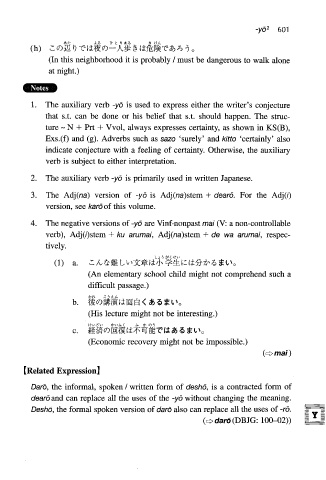Page 675 - Makino,Tsutusi.DictionaryOfIntermediateJGrammar
P. 675
Ot Ohh
(h) ZD%!I Tc&D--A$~ C&&T&?J 3.
(In this neighborhood it is probably I must be dangerous to walk alone
at night.)
1. The auxiliary verb -yo is used to express either the writer's conjecture
that s.t. can be done or his belief that s.t, should happen. The struc-
ture - N + Prt + Vvol, always expresses certainty, as shown in KS(B),
Exs.(f) and (g). Adverbs such as sazo 'surely' and kitto 'certainly' also
indicate conjecture with a feeling of certainty. Otherwise, the auxiliary
verb is subject to either interpretation.
2. The auxiliary verb -yo is primarily used in written Japanese.
3. The Adj(na) version of -yd is Adj(na)stem + deard. For the Adj(i)
version, see kar6of this volume.
4. The negative versions of -y6 are Vinf-nonpast rnai (V: a non-controllable
verb), Adj(17stem + ku arumai, Adj(na)stem + de wa arurnai, respec-
tively.
Lt.lb<Qb>
(1) a. ZAG% Lb\;SC@t;t/J\ $%kb=.t253d~a%~\~
(An elementary school child might not comprehend such a
difficult passage.)
b. @o%&tiEi8 < &JB%L\O
(His lecture might not be interesting.)
+vL< L + 03
%L\~
c. %~oEI@~&~~;~R?Tc~&~
6
(Economic recovery might not be impossible.)
(+ mai)
e elated Expression]
Dar6, the informal, spoken I written form of deshd, is a contracted form of
deard and can replace all the uses of the -yo without changing the meaning.
Deshd, the formal spoken version of dare also can replace all the uses of -r6.
(+ daM (DBJG: 100-02))

